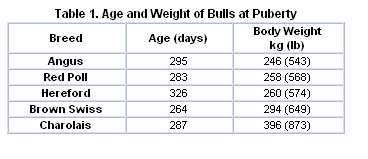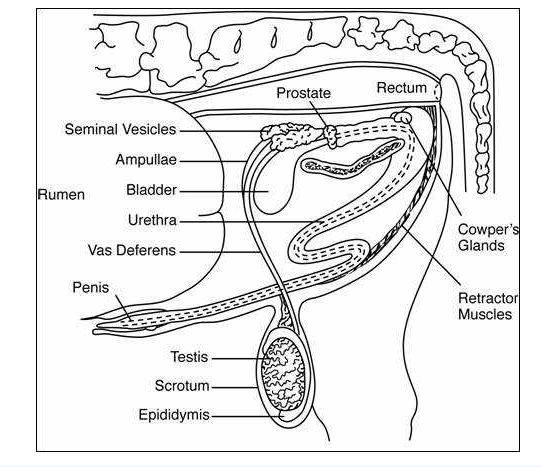



Maximizing Beef Bull Fertility and Reproduction
By T. Hamilton - Beef Cattle Specialist, OMAFRA - A major objective in a cow-calf operation is to produce one calf from each cow annually. The degree to which producers meet this goal influences their net income.Introduction
A key component of efficient calf production is a high fertility level in each breeding animal in the herd. Since individual bulls service many females, a deficiency in the breeding ability of one bull has a larger impact on herd productivity than fertility problems in a single female. Using a subfertile bull may lead to longer calving intervals, a lower number of calves produced and increased costs from wintering open females. All of these results cause serious economic loss to the cow-calf producer.Bull fertility is often measured by the percentage of cycling females exposed to the bull and impregnated during a specific time period (usually 60–90 days). Actual fertility levels are the result of a combination of genetic potential and environmental factors including nutrition, health, and cow and bull management. It is not feasible to determine true fertility before a bull is used in the herd. Nevertheless, a bull can be evaluated for breeding soundness and this information used to assess his potential fertility. A few bulls may be sterile, but most have fertility levels ranging from very high to very low.
Puberty
Puberty is defined as the age at which a bull is first able to produce an ejaculate containing 50 million sperm with a minimum of 10% motility (capable of motion). It is related to age, body weight and testes weight. Age and body weight at puberty vary across breeds (Table 1), but scrotal circumference at puberty (an indicator of testes weight) remains constant at 28–29 cm. Bulls exhibit first sexual interest about 3 weeks prior to puberty and attain mating ability about 6 weeks after puberty. Although bulls that have reached puberty can breed, reproductive capacity increases as the bull continues to mature. The reproductive development and performance of young bulls has gained attention as beef breeders attempt to accelerate improvement of economic traits in cattle and reduce costs by using younger sires.
Factors Affecting Bull Fertility
There are 5 general factors that can affect bull fertility:- structural soundness
- capability of the reproductive organs
- quality of semen
- level of libido
- plane of nutrition.
All are important and a deficiency in any category will negatively affect fertility.
Structural Soundness
General health and structural soundness are important aspects of fertility. Poor health can affect libido, mating ability, and semen production and quality. Structural soundness, including functional feet, legs and associated joints, is critical for the bull to effectively travel the breeding pasture and service females in heat. Any disease that impairs the mobility of the bull hinders reproductive performance.A conformational problem commonly associated with poor breeding performance is extreme straightness of the rear leg (post-legged). A moderate angle in the hock joints is necessary for the bull to thrust properly after mounting. Proper angulation in the leg joints also helps to absorb the shocks produced during each step and increases the productive life-span of the bull.
Reproductive Organs
Figure 1 illustrates the various parts of the bull’s reproductive tract. Sperm is produced continuously by the testes and stored in the epididymis. The prostate gland, seminal vesicles and cowper’s glands secrete the fluid component of the semen. During mating, the penis is extruded from the sheath by the straightening of the S-shaped sigmoid flexure; sperm are transported up the vas deferens to the urethra and exit via the penis.Deep body temperatures are too warm for proper sperm production. This is why testes are located outside the body core. As the environmental temperature changes, the testes are raised and lowered in the scrotum to maintain proper temperature for sperm production.
Abnormalities of the Reproductive Organs
Various conditions can affect the function of the reproductive tract. If the testicles cannot move because of fat pads, scar tissue or a small scrotum, proper temperature cannot be maintained and semen quality may suffer. Soft testicles indicate degeneration of tissue and poor semen quality. Very small testicles indicate unsatisfactory development of sperm-producing tissue. Severe frost-bite scabs, tumours or abscesses also indicate potential problems.Infection and inflammation can occur in any of the reproductive organs. If the testicles become inflamed, the semen quality may be impaired long after the original condition has passed, since it takes approximately 60 days for new sperm to be produced and mature.
Common penile problems include:
- spiral deviation
- persistent frenulum
- penile hair rings.
A persistent frenulum is a heritable condition in which the tip of the penis remains attached to the sheath and cannot be extended. It can be surgically corrected.
Penile hair rings are most often seen on young bulls. A band of hair encircles the penis. If the condition remains untreated infection and scarring may result. Other conditions that can affect the penis include fractures, warts and scarring from previous injuries.

Figure 1. The reproductive tract of the bull.
Scrotal Circumference
Measuring the scrotal circumference of young bulls is an accurate, repeatable method to assess current and future sperm-producing ability. The measurement gives an estimate of the weight of the testes, which is directly related to the level of sperm production. Scrotal measurement is also positively correlated with semen volume and quality. Table 2 contains minimum recommended scrotal measurements by breed and age. Bulls with adequate scrotal development for their age have a higher probability of becoming satisfactory breeders than bulls with smaller scrotal circumferences.Scrotal circumference is of medium to high heritability. Fertility of the male offspring can be increased by selection for this trait. The scrotal circumference of a bull is also positively related to the fertility of his daughters. Heifers from sires with larger than average scrotal circumference tend to reach puberty earlier than those from bulls with smaller scrotal circumferences. Increased scrotal circumference in sires is also favourably correlated to their daughter’s age at first breeding, pregnancy rate and days to rebreeding after calving. Due to low heritability, direct selection for female fertility traits has not been successful. The strong genetic relationship between scrotal circumference and female reproductive traits provides an alternative selection method.
Semen Quality
The criteria commonly used to evaluate semen quality include sperm morphology (structure) and motility (rate and percent of progressive forward movement). Semen volume and concentration can also be used.Consider the following points when assessing the results of a semen test.
- In the field, correlations between semen quality traits and fertility have been low to moderate.
- The repeatability of semen evaluations of the same bull over time have been low.
lSemen tests results for young bulls may not be conclusive. A poor semen test on a bull less than 15 months of age is not a reliable indicator that the bull will have poor quality semen a few weeks later. Seminal qualities may improve dramatically for up to 4 months following puberty.
While a bull must produce some viable sperm in order to be fertile, semen quality is only one aspect of total fertility and must be evaluated in conjunction with all the other factors.
Libido
Libido (sex drive) is a critical component of fertility. It is independent of scrotal circumference, semen quality, body weight, growth rate or masculinity. One method of measuring libido is to measure serving capacity. This is done by exposing the bull to a group of restrained females and recording the number of mounts and services completed in a given time period. This method, however, is time consuming and requires confining a number of females. Serving capacity is not commonly evaluated in Ontario at present.When 2 or more bulls are used at the same time, in the same pasture, social interactions affect breeding performance. Social rank is related to age and seniority in the herd. The most dominant bulls tend to complete the highest number of services. In this situation, the number of cows serviced may be related more to social dominance than libido as measured by a serving capacity test.
Nutrition
Proper nutrition is necessary for good reproductive performance. Balanced amounts of protein and energy are required for sperm production and the physical activity associated with breeding. Adequate amounts of vitamins and minerals are also important in reproduction.
During the breeding season, bulls tend to eat less feed than is required to maintain their body weight. At this time they use body fat for energy and may lose up to 68 kg (150 lb). Supplying a grain mix to bulls on pasture is not always effective. Proper pre-breeding nutrition is essential to ensure the bull has adequate reserves for a successful breeding season.
Excessive fat deposits in the scrotum may interfere with temperature regulation. The degree of body fat required to adversely affect sperm production has not been well defined. Extreme fatness has been associated with low serving capacity. On the other hand, large breed yearling bulls starting the breeding season with minimal levels of backfat may have poorer semen quality than similar bulls carrying a moderate level of backfat. The nutrient requirements needed to optimize reproductive performance in breeding bulls needs more research.
Cow to Bull Ratio
To produce a calf every 12 months, the cow must be bred within 80 days after calving. In order to achieve high pregnancy rates in a restricted breeding season, do not overwork the bulls. Table 3 shows the number of cows that a bull of average fertility can be expected to impregnate in a 60-day breeding season on pasture. Cow numbers may be increased by about 30% if cattle are kept in a confined area or are presented to the bull only when in heat. If cow estrous cycles are synchronized and natural mating is used, the cow:bull ratio must be reduced.
Summary
Proper selection and management of the beef bull will increase the probability of a successful breeding season. A complete assessment of potential fertility includes an evaluation of structural soundness, reproductive organs, semen quality, libido and nutritional status. Selection for increased scrotal circumference should increase inherent fertility in both male and female progeny.Selected References
-
Blockey. M. A. 1978. The Influence of Serving Capacity of Bulls on Herd Fertility. Journal of Animal Science 46:589.
-
Coulter, G.H. et al, 1987. Testicular Development, Daily Sperm Production and Epididymal Sperm Reserves in 15-Mo-Old Angus and Hereford Bulls: Effects of Bull Strain Plus Dietary Energy. Journal of Animal Science 64:254.
-
Lunstra, D.D. et al, 1978. Puberty in Beef Bulls: Hormone Concentrations, Growth, Testicular Development, Sperm Production and Sexual Aggressiveness in Bulls of Different Breeds. Journal of Animal Science 46:1054.
-
Pruitt, R. J. and L. R. Corah, 1985. Effects of Energy Intake After Weaning on the Sexual Development of Beef Bulls. 1. Semen Characteristics and Serving Capacity. Journal of Animal Science, 61:1186.
-
Wenkoff, M.S. 1987. The Evaluation of Bulls for Breeding Soundness. CVMA, 1987.
This Factsheet was originally authored by Tom Hamilton, Beef Cattle Production Systems Program Lead, New Liskeard, OMAFRA and Deb Stark, Chief Veterinarian of Ontario (formerly Cattle Health Consultant), Guelph, OMAFRA.
February 2007

